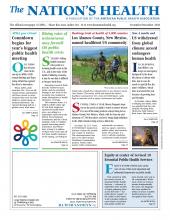
Carlos Ramirez, MD, examines Juan Perez in Oakland, California, in May at his clinic for people who lack insurance. Many people who have lost job-based coverage this year are Hispanic.
Photo by Jessica Christian, courtesy The San Francisco Chronicle/Getty Images
Steadily falling health insurance rates point to a looming health crisis in the U.S., and in the wake of the nation’s faltering economy, it may be one that is difficult to bounce back from.
Emerging research finds that the COVID-19 pandemic and the sustained damage it has done to the economy has resulted in major disruptions to health insurance coverage.
This summer alone, 3.3 million adults under age 65 lost their employer-sponsored health insurance, according to a September report from the Robert Wood Johnson Foundation and the Urban Institute, with 1.9 million people becoming newly uninsured. And before that, at least 5.4 million workers who were laid off lost their health insurance in the spring, according to Families USA.
But even before the pandemic and resulting economic crisis, health insurance coverage was falling in the U.S. New data released in September by the U.S. Census Bureau showed that in 2019, 9.2% of people — or 29.6 million — were not covered by health insurance at the time they were interviewed for the American Community Survey. The rate is an increase from 2018, when 8.9% of people were uninsured, according to the survey.
“We were drifting in a bad direction before the pandemic hit, and now we have had a real shock to our system,” Katherine Hempstead, PhD, RWJF senior policy adviser, told The Nation’s Health. “It’s shown a lot of vulnerabilities in our safety net.”
Last year, health insurance coverage increased in only one state, Virginia, which expanded Medicaid eligibility, and decreased in 19 others. Nationwide, Medicaid enrollment fell by almost one percentage point to 17.2%.
“This is the time we should be bolstering our social safety nets,” Benjamin Sommers, MD, PhD, health care economics professor at Harvard T.H. Chan School of Public Health, told The Nation’s Health. “Instead we’re seeing the erosion of hard-fought gains.”
Texas had the highest state uninsurance rate in 2019, with 18.4% of residents lacking coverage, followed by Oklahoma at 14.3%, Georgia at 13.4% and Florida at 13.2%. At the other end of the spectrum, only 3% of people in Massachusetts lacked insurance in 2019, as did 3.5% of people in Washington, D.C., and 4.1% in Rhode Island.
According to the September census report, “Health Insurance Coverage in the United States: 2019,” almost 16% of young adults ages 19 to 34 were uninsured in 2019, as were 5.7% of children under age 19.
Hispanics had the highest rate of uninsurance in 2019, at nearly 17%. That trend continued into the pandemic this year, when more than half of the people who lost their employer-sponsored insurance were Hispanic.
The consequences of not having insurance can be dire. According to a 2019 survey from the Kaiser Family Foundation, people who are uninsured are much more likely to have not visited a doctor or other health professional or clinic in the past year. They are also less likely to seek recommended preventive care, such as tests that can detect cancer or other serious diseases.
To prevent more health insurance loss in coming months, advocates are calling for interventions to protect the nation’s health.
“Right now, it is shocking that no COVID-19 legislation signed into law has yet taken major steps to protect comprehensive health insurance coverage,” Stan Dorn, director of the National Center for Coverage Innovation and senior fellow at Families USA, told The Nation’s Health. “The COVID-19 economic crash reminds us, once again, of the price we pay as a country for relying on employers for health insurance.”
The drop in U.S. insurance coverage last year came even as poverty fell, the census found. The official poverty rate in 2019 was 10.5%, a drop of 1.3 percentage points from 11.8% in 2018.
While health insurance coverage had been steadily growing since the Affordable Care Act was passed, those gains have eroded under the Trump administration, which has worked to undermine and dismantle the law and continues to challenge it in court.
According to a Sept. 30 brief from the National Center for Health Statistics, almost three-fourth of adults who did not have insurance in 2019 said it was because it was not affordable for them.
Because of the ACA, many people who became unemployed during the pandemic this year were able to switch from employer-sponsored insurance to other options. The ACA was able to offer some protection against the surge of joblessness caused by the pandemic, according to an August study in the New England Journal of Medicine.
The study found that post-ACA implementation, the likelihood of having insurance after a job loss was increased by six percentage points.
“It presented a pathway to coverage (for people who lost their employer-sponsored insurance) in states with expanded Medicaid,” said Sommers, who is a study author. “It cushioned the blow, but there are pretty big gaps.”
The complete picture of how the pandemic worsened access to affordable care and health outcomes may not be known for some time, though they may be lasting.
“The damage to the economy and joblessness was rapid — but that doesn’t mean recovery will be equally as rapid,” Sommers said.
For more information, visit www.census.gov.
- Copyright The Nation’s Health, American Public Health Association









